Embark on a journey through Bhutan's majestic valleys, where the Himalayan landscape unfolds its serene and untouched beauty. Known for their breathtaking vistas and deep cultural significance, Bhutan's Scenic Valleys offer a tranquil retreat into nature's lap. From the historical depths of Paro Valley, with its iconic Tiger's Nest Monastery, to the spiritual serenity of Bumthang, each valley presents a unique story of Bhutan's heritage and natural splendor. Ideal for explorers, spiritual seekers, and photography enthusiasts, these scenic valleys showcase the best of Bhutan's Landscapes and cultural richness. Whether you're trekking through lush trails or exploring ancient dzongs, Bhutan's Valleys are a must-visit for anyone seeking an authentic and enriching travel experience. Join us as we delve into the heart of the Dragon Kingdom, where every valley promises an adventure and a peek into the soul of Bhutan.
At Amen Bhutan Tours and Treks, we pride ourselves on being the premier tour operator for exploring Bhutan's Scenic Valleys. Our expertly crafted tours are designed to showcase the breathtaking beauty and rich cultural tapestry of Bhutan. From the lush, historic landscapes of Paro Valley to the spiritual depths of Bumthang, our tours provide an unmatched experience. With a deep understanding of the local culture and a commitment to providing exceptional service, Amen Bhutan Tours and Treks is your ideal partner for discovering the hidden treasures of Bhutan. Join us for an unforgettable journey through the heart of the Dragon Kingdom, where every valley and every vista speaks to the soul of this mystical land.
Paro Valley
Paro Valley is one of Bhutan's most enchanting and well-known regions, often serving as the gateway for travelers entering the country. This picturesque valley encapsulates the essence of Bhutan's natural beauty and rich cultural heritage. Here are some key highlights and reasons why Paro Valley is a must-visit destination:
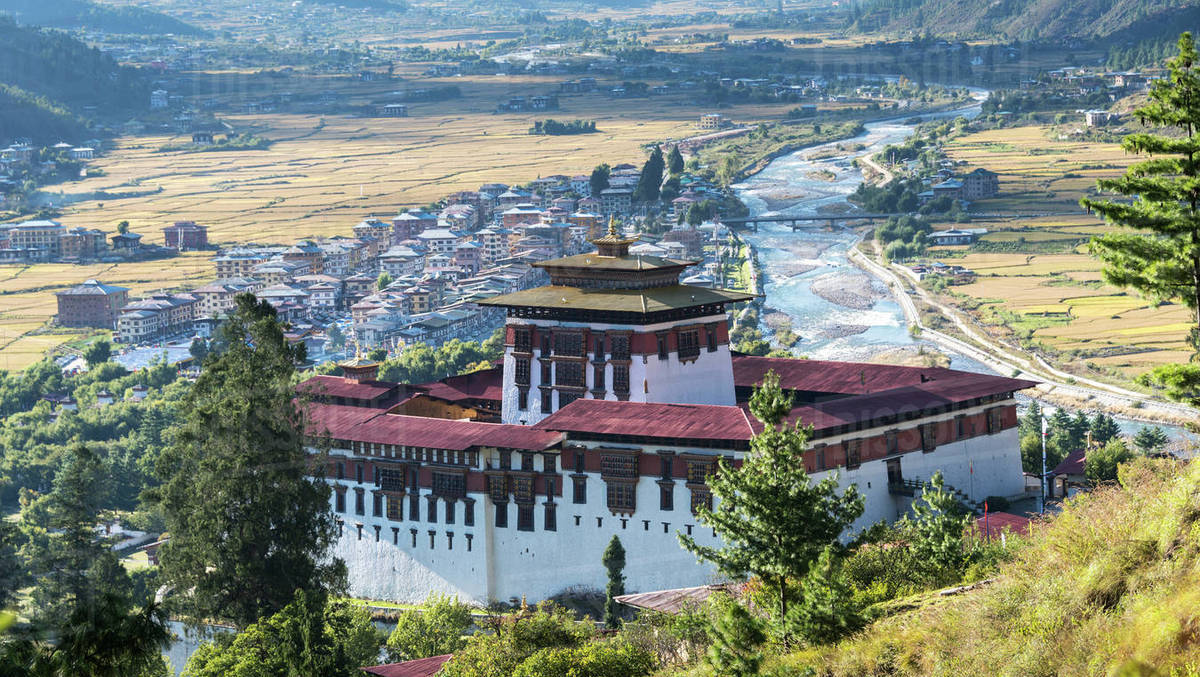
- Natural Beauty: Paro is renowned for its verdant and fertile landscapes, surrounded by rugged mountains and dotted with traditional Bhutanese farmhouses. The Paro Chhu (river) meanders through the valley, adding to its serene atmosphere. The valley comes alive with color in the spring when the cherry blossoms bloom, making it a photographer's paradise.
- Architectural Marvels: The iconic Taktsang Monastery, also known as the Tiger's Nest, is perched on a cliff about 900 meters above the Paro Valley. It's not only a stunning sight but also an important pilgrimage site for Buddhists. The trek to this monastery is one of the most spiritual and physically rewarding journeys one can undertake in Bhutan.
- Cultural Richness: Paro is a treasure trove of Bhutanese culture, with over 155 temples and monasteries in the area. Some of the most significant include Rinpung Dzong, known as the Fortress on a Heap of Jewels, and Kyichu Lhakhang, one of the oldest temples in Bhutan. These sites offer deep insight into the spiritual and historical aspects of Bhutanese life.
- Festivals: The Paro Tshechu is one of Bhutan’s most popular religious festivals, attracting tourists and locals alike. Held annually in the spring, it features masked dances performed by monks and laymen in elaborate costumes that represent deities, demons, and animals. This festival is a vibrant display of Bhutanese culture and an excellent opportunity for visitors to experience the spirit of the Bhutanese community.
- Adventure and Leisure Activities: Apart from cultural tours, Paro offers a range of activities for adventure enthusiasts and leisure seekers. The valley is ideal for hiking and mountain biking. The Chele La pass, one of the highest motorable roads in Bhutan, provides stunning panoramic views of the surrounding mountains, including sacred Jomolhari and Jichu Drake.
Paro Valley not only captivates with its natural beauty and historical sites but also warmly welcomes visitors with its peaceful atmosphere and the hospitality of local people. Whether you're a spiritual seeker, a culture enthusiast, or an adventure lover, Paro provides a unique and memorable experience that reflects the best of Bhutan.
Thimphu Valley
Thimphu Valley, the capital and largest city of Bhutan, blends ancient tradition with the conveniences of modern life, making it a unique destination within the Himalayan Kingdom. Nestled in the western part of Bhutan, Thimphu is both the political heart and a cultural hub of the country, offering visitors a distinct and comprehensive view of Bhutanese culture and lifestyle.
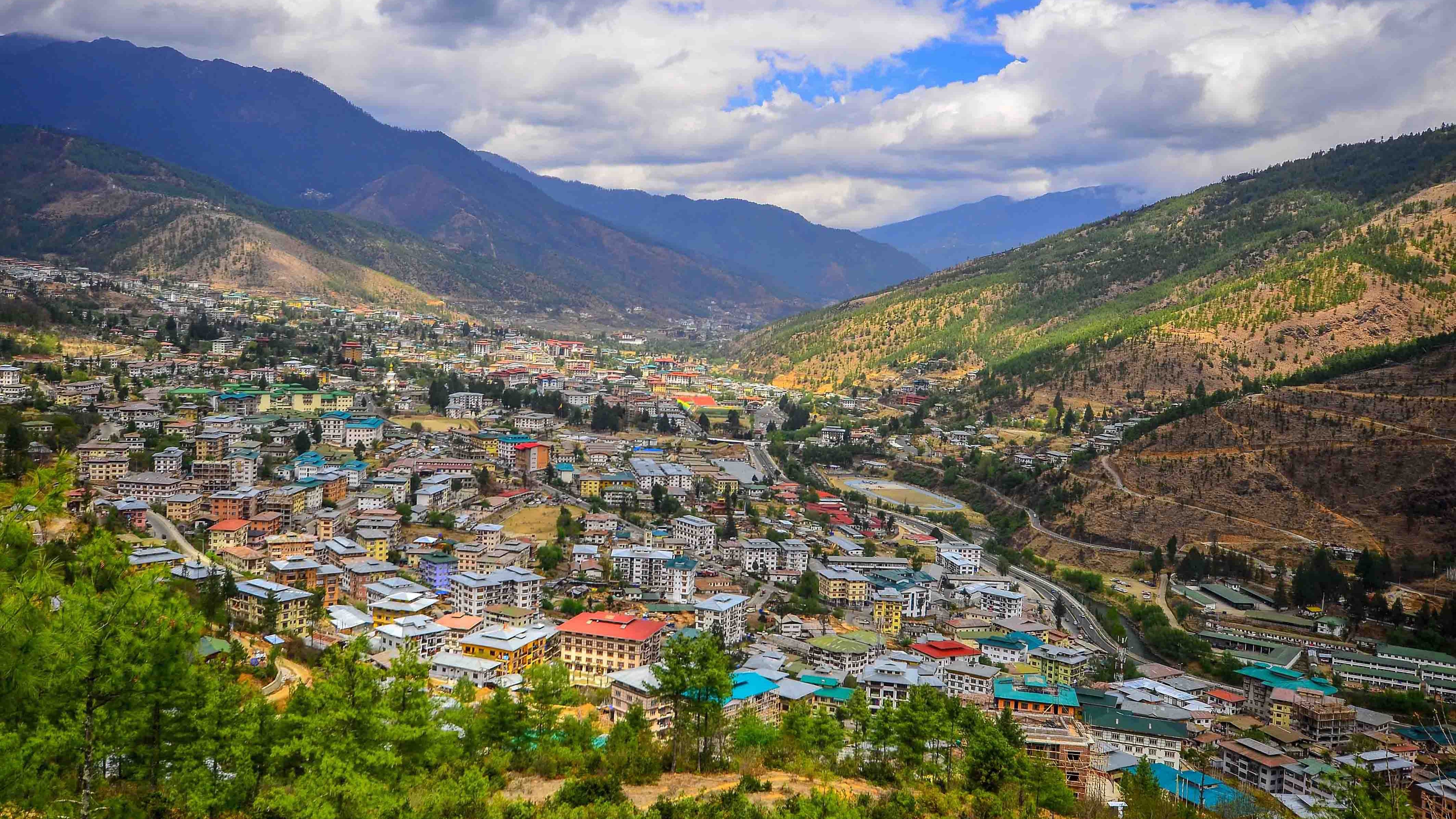
- Vibrant Culture and Heritage: Thimphu is home to several of Bhutan's most important cultural landmarks. The Tashichho Dzong, a stunning Buddhist monastery and fortress, serves as the seat of the Bhutanese government and houses the offices of the King and the Throne Room. This dzong is a prime example of Bhutanese architecture and offers insight into the spiritual and administrative life of the country.
- Modern Attractions: Unlike many global capitals, Thimphu does not have traffic lights, adding to its charm. Instead, policemen direct traffic in a dance-like manner at major intersections. The city also boasts the National Memorial Chorten, which is highly revered and attracts residents and visitors for daily prayers. The Textile Museum and Folk Heritage Museum provide deeper insights into Bhutanese material culture and traditional Bhutanese life.
- Religious Sites: One of Thimphu's notable religious sites is the Buddha Dordenma, a gigantic Shakyamuni Buddha statue made of bronze and gilded in gold. Perched on a hill overlooking the valley, it symbolizes the omnipresence of the Buddha. The statue contains thousands of smaller Buddha statues, each also made of bronze and gilded in gold.
- Festivals and Events: Thimphu is lively with festivals, especially the Thimphu Tshechu, one of the biggest religious festivals in Bhutan. Held in the autumn at the Tashichho Dzong, this event showcases the rich traditions of Bhutanese dance and music, along with elaborate handmade costumes and masks. The festival not only serves as a spiritual occasion but also as a social gathering, bringing together families and communities.
- Shopping and Dining: Thimphu also offers a variety of shopping and dining options that reflect a mix of traditional Bhutanese and modern international influences. Handicraft markets provide an opportunity to purchase authentic Bhutanese souvenirs such as hand-woven textiles, carved wooden items, and Bhutanese stamps. For dining, visitors can explore both traditional Bhutanese cuisine and a range of international dishes.
- Natural Beauty: Despite its status as a capital city, Thimphu is surrounded by nature and offers easy access to several hiking and trekking trails. The Motithang Takin Preserve, a wildlife reserve area for takin, Bhutan's national animal, is a short drive from the center and provides a unique wildlife viewing experience.
Thimphu Valley offers a wonderful blend of the old and new, providing visitors with a comprehensive view of the kingdom's past, present, and future. It remains a place where Bhutanese traditions are preserved with great pride even as the nation slowly embraces modernization.
Punakha Valley
Punakha Valley, with its deep historical significance and breathtaking natural beauty, stands as one of the most enchanting destinations in Bhutan. Formerly the capital of Bhutan, Punakha is known for its mild climate and fertile land, making it a lush and vibrant area compared to the more rugged terrains found elsewhere in the country.
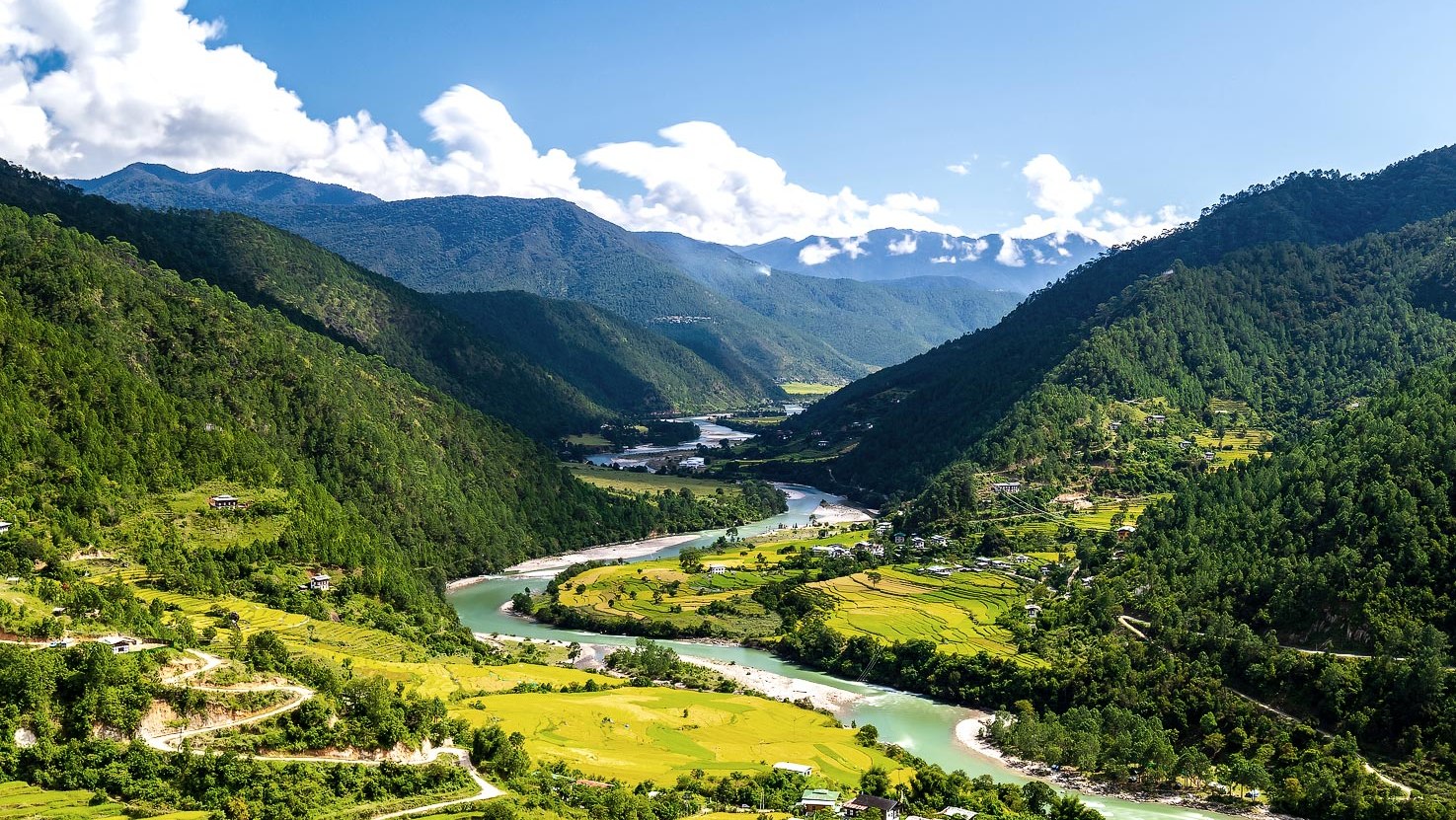
- Historical Significance: Punakha holds a treasured place in Bhutan's history as it was the capital until 1955 and continues to be the winter residence of the central monastic body. The Punakha Dzong, also known as Pungthang Dewachen Phodrang (Palace of Great Happiness), is the main attraction here. Located at the confluence of the Pho Chhu (father) and Mo Chhu (mother) rivers, the dzong is an architectural masterpiece that dates back to the 17th century. It has been the site of coronations for all of Bhutan's kings and continues to play a vital role during significant national and religious celebrations.
- Architectural Marvel: The Punakha Dzong stands as a symbol of unity and peace in Bhutan. It’s one of the most beautiful dzongs in the country, renowned for its intricate woodwork and artistic detail. The structure is especially mesmerizing in spring when the lilac-colored jacaranda trees surrounding it are in full bloom. The interior of the dzong is equally impressive, featuring elaborate wall paintings that depict the life of Buddha and various bodhisattvas.
- Natural Beauty: The valley itself is exceptionally scenic, characterized by terraced rice fields that cascade down to the riverbanks and the surrounding pine-covered hills. This fertile valley produces abundant crops and fruits, such as rice, oranges, and bananas, making Punakha an important agricultural center for Bhutan.
- Cultural Festivals: The Punakha Tshechu is one of the most popular festivals in Bhutan, held annually in the dzong. It features mask dances, traditional music, and dramatic re-enactments of scenes from Bhutanese history, particularly the story of Zhabdrung Ngawang Namgyal, the unifier of Bhutan. Another significant event is the Punakha Drubchen, a unique celebration that reenacts the 17th-century battle in which Bhutanese forces repelled Tibetan invaders.
- Adventure and Recreation: For those seeking adventure, Punakha offers several trekking and rafting opportunities. The rivers flowing through Punakha are popular for white-water rafting, providing thrilling rides with a backdrop of stunning landscapes. The valley also serves as a starting point for numerous treks, including the beautiful routes to Khamsung Yulley Namgyal Choling Monastery.
- Sustainable Tourism: Punakha is also at the forefront of Bhutan’s efforts in sustainable tourism, with various eco-friendly lodges and community-led tourism initiatives that help preserve the natural and cultural heritage of the valley.
With its rich history, stunning architecture, and vibrant festivals, Punakha Valley not only showcases Bhutan's past but also offers a glimpse into the continuing traditions that are the backbone of Bhutanese identity. Whether you're exploring the grandeur of the Punakha Dzong, participating in the vibrant local festivals, or enjoying the natural splendor of the landscape, Punakha promises an enriching and memorable experience.
Phobjikha Valley
Phobjikha Valley, also known as Gangteng Valley after the impressive Gangteng Monastery located there, is a stunning glacial valley on the western slopes of the Black Mountains in central Bhutan. This valley stands out for its vast expanses of green and its significant ecological value. It is one of Bhutan's most important wildlife preserves and a vital habitat for the rare and beautiful black-necked cranes that migrate here from the Tibetan Plateau every winter.
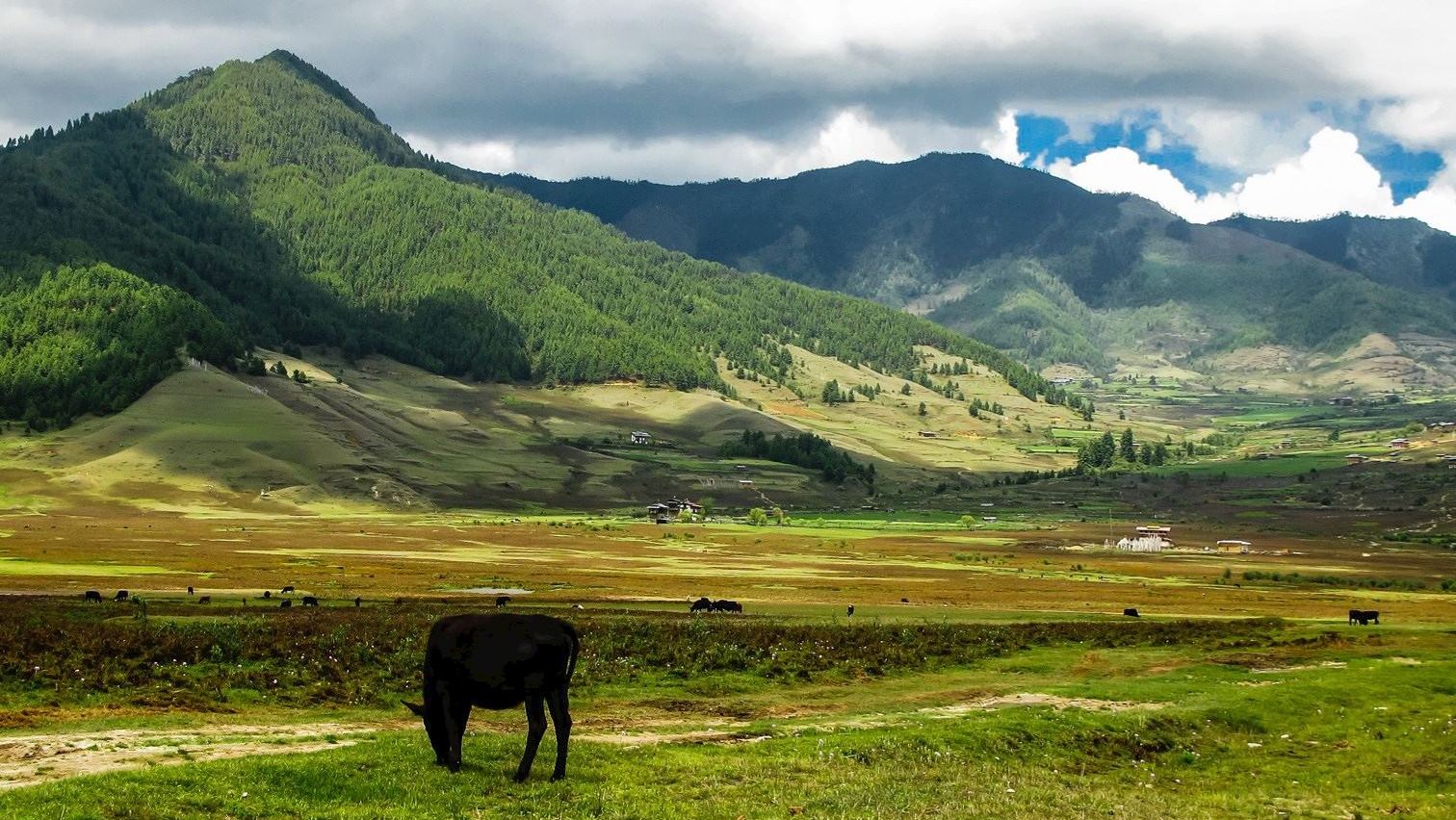
- Natural Beauty and Conservation: The valley's landscape is characterized by gently sloping hillsides covered with dwarf bamboo, which is the primary food source for the black-necked cranes during their stay from late October to mid-February. The conservation efforts in Phobjikha are a prime example of Bhutan's commitment to preserving its natural environment. The valley is part of the Black Mountains National Park, which serves as a corridor for the migration of various endangered species.
- Cultural Significance: Phobjikha is also notable for its spiritual significance. The Gangteng Monastery, dating back to the 17th century, is an important religious site for the Nyingma school of Buddhism and dominates the valley's cultural landscape. The monastery hosts the annual Black-Necked Crane Festival, a vibrant and joyful event that celebrates the crane's arrival. This festival includes cultural dances, songs, and plays performed by the local school children and monks, focusing on crane conservation and the local culture of the valley.
- Sustainable Living: The residents of Phobjikha Valley live in harmony with their natural surroundings, following sustainable farming practices and using traditional methods that have minimal impact on the environment. This sustainable approach extends to the local tourism industry as well, with community-based tourism initiatives that promote eco-friendly practices and benefit the local population directly.
- Trekking and Outdoor Activities: For outdoor enthusiasts, Phobjikha Valley offers a variety of trekking opportunities that allow visitors to immerse themselves in its serene beauty. The Gangteng Trek, which starts from the valley, is a popular route that offers panoramic views of the valley and its surroundings. The trek is relatively easy, making it accessible to most fitness levels, and it provides an excellent opportunity to observe the local flora and fauna.
- Photographic Opportunities: The valley is a haven for photographers, thanks to its aesthetic landscapes and the majestic presence of the black-necked cranes. The contrast between the lush green of the valley floor and the stark black and white of the cranes creates a compelling visual spectacle that attracts nature photographers from around the world.
Phobjikha Valley is a place where the beauty of nature, the depth of cultural heritage, and the essence of Bhutanese spirituality converge. It offers a tranquil retreat from the modern world and a chance to see Bhutan's environmental conservation efforts in action. Whether you're a nature lover, a culture enthusiast, or just seeking peace, Phobjikha Valley promises an enriching and unforgettable experience.
Bumthang Valley
Bumthang Valley, often referred to as the spiritual heartland of Bhutan, is nestled in the central part of the country. This valley is distinguished not just for its beautiful landscape but also for its historical and spiritual significance. Bumthang is composed of four main valleys: Chokhor, Tang, Ura, and Chhume, each with its own unique charm and attractions.
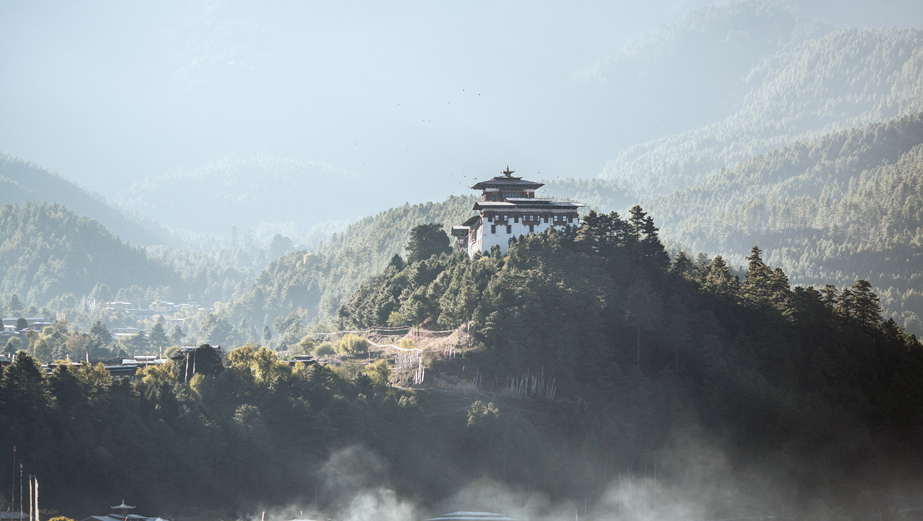
- Rich Spiritual Heritage: Bumthang is considered the most historic dzongkhag (district) in Bhutan, featuring some of the oldest temples and monasteries in the kingdom. The Jakar Dzong, also known as the "Castle of the White Bird," dominates the Chokhor valley skyline and serves as an administrative center and monastic complex. The valley is also home to Jambay Lhakhang, one of the 108 temples built by Tibetan King Songtsen Gampo in the 7th century to subdue evil spirits in the Himalayan region.
- Cultural Significance: The spiritual depth of Bumthang is further highlighted by the numerous sacred sites and events that take place in the region. It hosts several significant religious festivals, including the Jambay Lhakhang Drup and the Ura Yakchoe. These festivals feature masked dances, religious rituals, and a communal celebration that provides deep insight into the Bhutanese way of life and spiritual practices.
- Natural Beauty: The natural scenery in Bumthang is diverse, ranging from lush, broad valleys to steep mountains and dense forests. This variation in landscape makes it an ideal location for nature lovers. The valleys are rich in agricultural produce, especially apples and dairy products, which contribute to the local cuisine's distinct flavors.
- Adventure and Exploration: Bumthang is also a prime destination for trekking enthusiasts, with numerous trails that offer both challenging and more accessible routes. The Bumthang Cultural Trek is particularly popular, providing hikers with a scenic tour through villages, monasteries, and fields, while offering a glimpse of the traditional Bhutanese rural life.
- Preservation of Arts and Crafts: The valley is renowned for its yathra weaving, which is a traditional form of patterned wool weaving unique to Bumthang. Visitors can explore local shops and cooperatives to watch weavers at work and purchase handcrafted textiles as souvenirs. The artisanship reflects the cultural richness and ingenuity of the local people.
- Local Life and Cuisine: Bumthang’s local cuisine is notable for its incorporation of dairy and organic products into traditional dishes, offering a distinctive taste that differs from other regions in Bhutan. Cheese, buckwheat, and locally brewed spirits are staples in Bumthang's culinary offerings, providing a taste of the valley’s agricultural bounty.
Bumthang Valley not only captivates visitors with its serene landscapes and spiritual sites but also engages them through its rich history, vibrant cultural festivals, and local crafts. This combination of natural beauty, historical depth, and cultural richness makes Bumthang a quintessential reflection of Bhutan’s spirit and traditions, rendering it a must-visit for anyone seeking a deeper understanding of Bhutanese life.
Haa Valley
Haa Valley, nestled in the north-western part of Bhutan near the Indian border, is one of the kingdom's most picturesque and least explored regions. This secluded valley is known for its pristine alpine forests, tranquil rural atmosphere, and rich cultural heritage, making it a unique destination for those looking to experience the untouched beauty and traditional lifestyle of Bhutan.
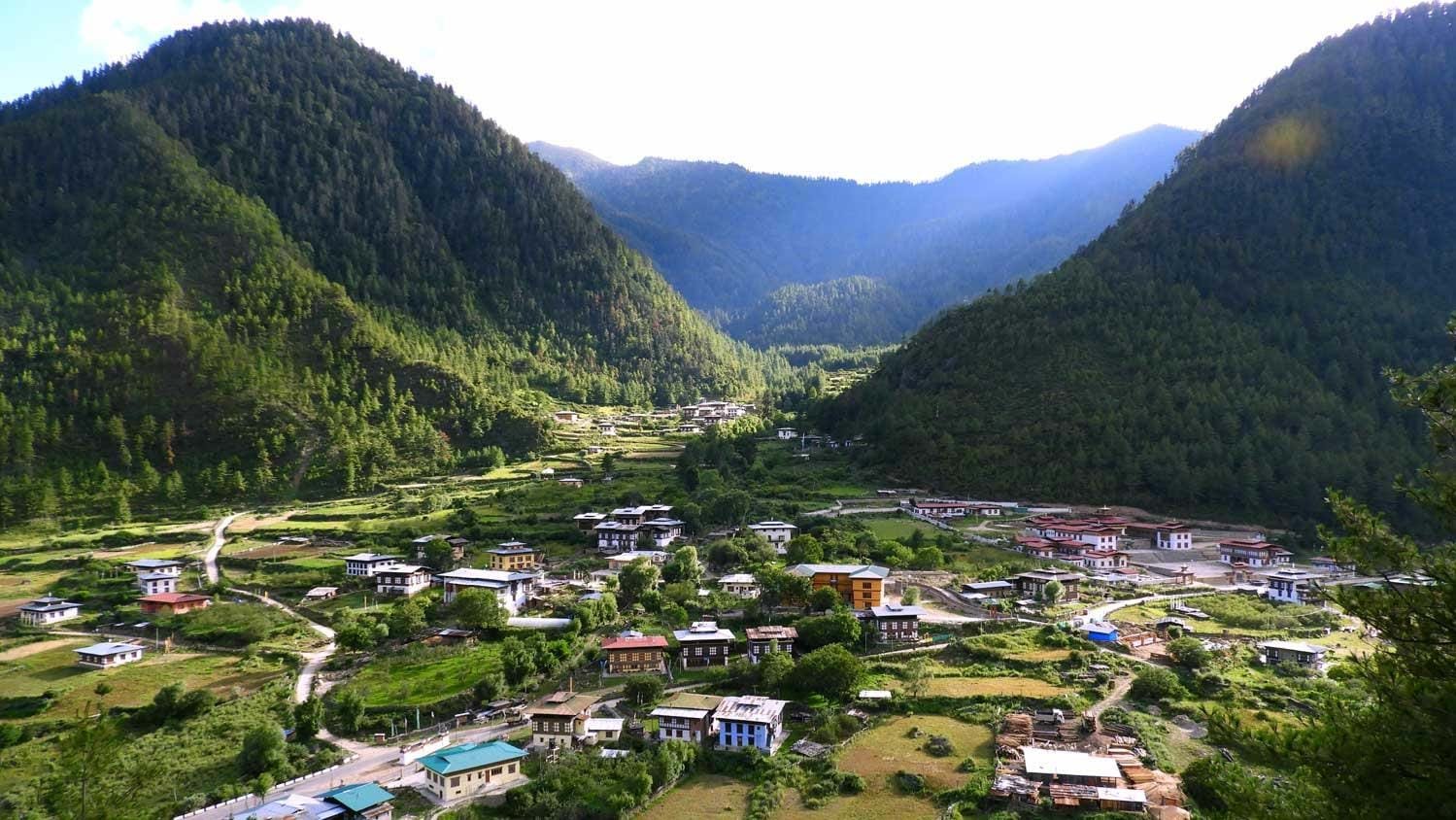
- Pristine Natural Beauty: The landscape of Haa Valley is dominated by verdant rolling hills and craggy mountain peaks covered with dense pine and fir forests. The Haa Chhu River flows through the valley, enhancing the serene and picturesque setting. This remote area is ideal for nature lovers, offering breathtaking views and opportunities for numerous outdoor activities, including hiking, biking, and fishing.
- Cultural Richness: Despite its small size, Haa Valley is steeped in cultural and spiritual history. It features several ancient temples and forts. The Lhakhang Karpo (White Temple) and Lhakhang Nagpo (Black Temple), located in the tiny village of Dumchoe, are two of the oldest and most significant religious sites in the valley, believed to have been built by Tibetan king Songtsen Gampo in the 7th century as part of a network of 108 monasteries.
- Traditional Lifestyle: The valley's isolation from the mainstream tourist routes has helped preserve its traditional way of life. The Haaps, the people of Haa, still practice their age-old customs, traditions, and agricultural practices. They are known for their hospitality and the festive spirit they display during local festivals like the Haa Summer Festival. This event showcases traditional living-culture, yak riding, and local cuisines, providing visitors with a genuine insight into the life and culture of the Haa Valley.
- Spiritual Significance: Haa Valley is considered sacred in Bhutanese culture due to its connection with the mythical and protective deities. Local folklore is rich with tales of the valley's protective deities known as "Ap Chundu" and other spirits who are believed to reside in the surrounding mountains and forests. The spiritual atmosphere is palpable, with numerous shrines and prayer flags found throughout the area.
- Adventure and Tranquility: For those seeking a blend of adventure and peace, Haa Valley offers a perfect escape. The valley's trails provide excellent trekking opportunities, including routes that connect Haa with the neighboring Paro Valley. The trek is not only physically rewarding but also offers spiritual rejuvenation, as the paths take pilgrims and travelers past numerous sacred and historical sites, through stunning landscapes that are both invigorating and calming.
- Conservation Efforts: Haa Valley's environment is meticulously protected, with initiatives in place to maintain its ecological balance and traditional aesthetics. The introduction of sustainable tourism practices ensures that visits are responsible and beneficial to the local community, preserving this gem for future generations.
Haa Valley remains one of Bhutan's hidden treasures, offering a rare glimpse into the traditional Bhutanese pastoral life amidst a backdrop of incredible natural beauty. For travelers seeking an authentic experience away from the more frequented tourist destinations, Haa Valley provides a profound connection to nature and Bhutanese culture.
Bhutan's scenic valleys offer a breathtaking tapestry of natural beauty, rich cultural heritage, and spiritual depth that is unparalleled. From the iconic Paro Valley with its famous Tiger's Nest Monastery to the serene and spiritual Bumthang, each valley presents a unique facet of Bhutan's identity. The tranquil Haa Valley, the historically significant Punakha, and the wildlife-rich Phobjikha, further enrich the diverse landscape of the Dragon Kingdom. These valleys are not just travel destinations; they are gateways to experiencing the heart and soul of Bhutan. Visitors leave with a sense of peace, a deeper understanding of Bhutanese culture, and memories of some of the most stunning and unspoiled landscapes in the world. Whether you seek adventure, spirituality, or a quiet retreat into nature, Bhutan’s scenic valleys offer a profound and enriching journey that resonates long after the journey ends.
FAQs of the Bhutan's Scenic Valleys
Q: What is the best time to visit Bhutan’s scenic valleys?
A: The best time to visit Bhutan's valleys largely depends on what you want to experience. Spring (March to May) is ideal for witnessing blooming flowers and pleasant weather, while autumn (September to November) offers clear skies and the famous Tshechus (festivals). Winter (December to February) is perfect for visiting the western valleys and enjoying the migratory birds in Phobjikha Valley.
Q: How can I access the valleys in Bhutan?
A: Most valleys in Bhutan are accessible by road, though some remote areas may require trekking. Paro, Thimphu, Punakha, and Bumthang are well-connected by motorable roads. For more secluded valleys like Haa and Phobjikha, conditions can vary, and in some cases, you might need to trek.
Q: Do I need a guide to explore the valleys?
A: Yes, Bhutanese law requires all tourists (except citizens of India, Bangladesh, and the Maldives) to have a guide. This regulation ensures that visitors get insightful and safe experiences while also preserving Bhutan's culture and environment.
Q: What should I pack for a trip to Bhutan’s valleys?
A: Packing depends on the season and activities planned. Essentials include warm clothing (layers are recommended), comfortable hiking boots, a rain jacket, sun protection (sunglasses, sunblock, hat), a camera, and any necessary medications. If you plan to trek, bring appropriate gear and a sturdy backpack.
Q: Are there specific cultural etiquettes I should follow in the valleys?
A: Bhutanese culture is deeply respectful of its traditions. Dress modestly, especially when visiting religious sites. Always ask permission before taking photos of people or religious ceremonies. It’s also customary to remove your shoes before entering temples and homes.
Q: What are some must-visit scenic valleys in Bhutan?
A: Must-visit valleys include Paro Valley for the Tiger’s Nest Monastery; Thimphu Valley for the cultural sites; Punakha Valley for its historic Dzong; Phobjikha Valley for nature and bird watching; and Bumthang for spiritual tours and natural beauty.
Q: What wildlife can I expect to see in Bhutan’s valleys?
A: The wildlife varies by valley but includes species like the black-necked crane in Phobjikha, takins in Thimphu, and various endemic birds across the country. The national parks and protected areas offer opportunities to see Bhutan’s diverse fauna.
Q: Are there any health considerations I should be aware of before traveling?
A: Travelers should be prepared for Bhutan's higher altitudes, especially in trekking regions. Acclimatization days are recommended. Also, ensure you have travel insurance that covers altitude sickness and medical evacuation if necessary.
Q: What are the accommodation options in the valleys?
A: Accommodation ranges from luxury hotels and resorts to homestays and guesthouses. In more remote areas like Phobjikha and Haa, options might be limited to simpler guesthouses and homestays, providing a more authentic experience.
Q: Can I visit Bhutan’s valleys independently?
A: Independent travel is restricted in Bhutan. Visitors must either be part of a tour or guests of a Bhutanese national. All tours must be booked through a registered Bhutanese tour operator.
If you are looking for tour packages in Bhutan please click here
If you need any further information, please contact us, Email: at [email protected] , Phone (Whatsapp or Viber) +975-1755-663
